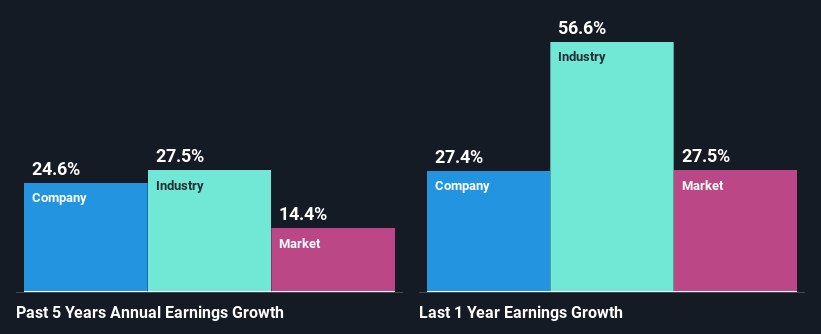Is The Buckle, Inc.'s (NYSE:BKE) Stock's Recent Performance Being Led By Its Attractive Financial Prospects?
Buckle's (NYSE:BKE) stock is up by a considerable 11% over the past week. Given the company's impressive performance, we decided to study its financial indicators more closely as a company's financial health over the long-term usually dictates market outcomes. Specifically, we decided to study Buckle's ROE in this article.
ROE or return on equity is a useful tool to assess how effectively a company can generate returns on the investment it received from its shareholders. In short, ROE shows the profit each dollar generates with respect to its shareholder investments.
Check out our latest analysis for Buckle
How Is ROE Calculated?
ROE can be calculated by using the formula:
Return on Equity = Net Profit (from continuing operations) ÷ Shareholders' Equity
So, based on the above formula, the ROE for Buckle is:
71% = US$253m ÷ US$354m (Based on the trailing twelve months to April 2022).
The 'return' refers to a company's earnings over the last year. So, this means that for every $1 of its shareholder's investments, the company generates a profit of $0.71.
What Is The Relationship Between ROE And Earnings Growth?
Thus far, we have learned that ROE measures how efficiently a company is generating its profits. We now need to evaluate how much profit the company reinvests or "retains" for future growth which then gives us an idea about the growth potential of the company. Assuming all else is equal, companies that have both a higher return on equity and higher profit retention are usually the ones that have a higher growth rate when compared to companies that don't have the same features.
Buckle's Earnings Growth And 71% ROE
Firstly, we acknowledge that Buckle has a significantly high ROE. Additionally, the company's ROE is higher compared to the industry average of 33% which is quite remarkable. So, the substantial 25% net income growth seen by Buckle over the past five years isn't overly surprising.
We then performed a comparison between Buckle's net income growth with the industry, which revealed that the company's growth is similar to the average industry growth of 28% in the same period.
Earnings growth is a huge factor in stock valuation. The investor should try to establish if the expected growth or decline in earnings, whichever the case may be, is priced in. By doing so, they will have an idea if the stock is headed into clear blue waters or if swampy waters await. If you're wondering about Buckle's's valuation, check out this gauge of its price-to-earnings ratio, as compared to its industry.
Is Buckle Efficiently Re-investing Its Profits?
Buckle has a three-year median payout ratio of 28% (where it is retaining 72% of its income) which is not too low or not too high. By the looks of it, the dividend is well covered and Buckle is reinvesting its profits efficiently as evidenced by its exceptional growth which we discussed above.
Additionally, Buckle has paid dividends over a period of at least ten years which means that the company is pretty serious about sharing its profits with shareholders.
Summary
Overall, we are quite pleased with Buckle's performance. Particularly, we like that the company is reinvesting heavily into its business, and at a high rate of return. Unsurprisingly, this has led to an impressive earnings growth. Having said that, the company's earnings growth is expected to slow down, as forecasted in the current analyst estimates. To know more about the latest analysts predictions for the company, check out this visualization of analyst forecasts for the company.
Have feedback on this article? Concerned about the content? Get in touch with us directly. Alternatively, email editorial-team (at) simplywallst.com.
This article by Simply Wall St is general in nature. We provide commentary based on historical data and analyst forecasts only using an unbiased methodology and our articles are not intended to be financial advice. It does not constitute a recommendation to buy or sell any stock, and does not take account of your objectives, or your financial situation. We aim to bring you long-term focused analysis driven by fundamental data. Note that our analysis may not factor in the latest price-sensitive company announcements or qualitative material. Simply Wall St has no position in any stocks mentioned.

